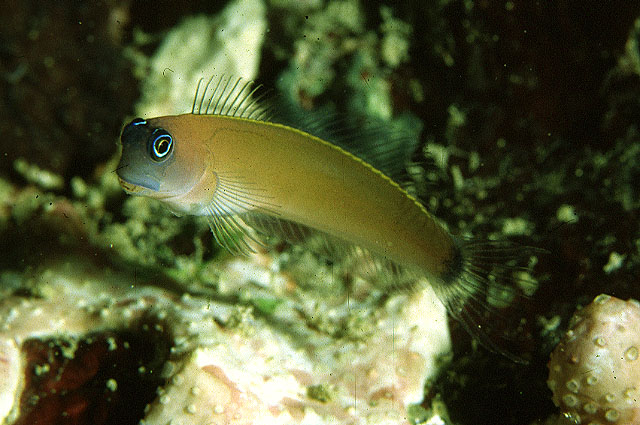| Blenniidae (Combtooth blennies), subfamily: Salariinae |
| 5.5 cm TL (male/unsexed) |
|
reef-associated; marine; depth range 10 - 37 m |
| Western Indian Ocean: Red Sea and Gulf of Aqaba; south to Djetta, Saudi Arabia and Towartit Reef, Sudan. |
|
Dorsal spines (total): 12-13; Dorsal soft rays (total): 16-18; Anal spines: 2-2; Anal soft rays: 19-20; Vertebrae: 34-37. Dorsal fin XII or XIII (rarely XII),16-18 (rarely 18), deeply notched between spinous and segmented ray sides. Anal fin II,19 or 20. Pectoral fin 13-15 (typically 14). Segmented caudal-fin rays 13. Vertebrae 10 or 11 (rarely 10) + 23-26 (typically 24 or 25) = 34-37 (rarely 34). Dentary
incisor teeth which includes anterior canine teeth very similar in appearance with incisors 46-57; posterior dentary canines 0 or 1 (rarely 0) on each side. Lateral line without pairs
of pores, terminating posteriorly at a point between verticals from dorsal-fin spines 8 and 10. With cirrus on posterior rim of anterior nostril; absent on anterior rim. |
| Adults occur in coral reefs. Secretive (Ref. 9710). Oviparous. Eggs are demersal and adhesive (Ref. 205), and are attached to the substrate via a filamentous, adhesive pad or pedestal (Ref. 94114). Larvae are planktonic, often found in shallow, coastal waters (Ref. 94114). |
|
Least Concern (LC); Date assessed: 24 March 2009 Ref. (130435)
|
| harmless |
Source and more info: www.fishbase.org. For personal, classroom, and other internal use only. Not for publication.

